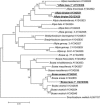Biodiversity of amoebae and amoeba-resisting bacteria in a hospital water network
- PMID: 16597941
- PMCID: PMC1449017
- DOI: 10.1128/AEM.72.4.2428-2438.2006
Biodiversity of amoebae and amoeba-resisting bacteria in a hospital water network
Abstract
Free-living amoebae (FLA) are ubiquitous organisms that have been isolated from various domestic water systems, such as cooling towers and hospital water networks. In addition to their own pathogenicity, FLA can also act as Trojan horses and be naturally infected with amoeba-resisting bacteria (ARB) that may be involved in human infections, such as pneumonia. We investigated the biodiversity of bacteria and their amoebal hosts in a hospital water network. Using amoebal enrichment on nonnutrient agar, we isolated 15 protist strains from 200 (7.5%) samples. One thermotolerant Hartmannella vermiformis isolate harbored both Legionella pneumophila and Bradyrhizobium japonicum. By using amoebal coculture with axenic Acanthamoeba castellanii as the cellular background, we recovered at least one ARB from 45.5% of the samples. Four new ARB isolates were recovered by culture, and one of these isolates was widely present in the water network. Alphaproteobacteria (such as Rhodoplanes, Methylobacterium, Bradyrhizobium, Afipia, and Bosea) were recovered from 30.5% of the samples, mycobacteria (Mycobacterium gordonae, Mycobacterium kansasii, and Mycobacterium xenopi) were recovered from 20.5% of the samples, and Gammaproteobacteria (Legionella) were recovered from 5.5% of the samples. No Chlamydia or Chlamydia-like organisms were recovered by amoebal coculture or detected by PCR. The observed strong association between the presence of amoebae and the presence of Legionella (P < 0.001) and mycobacteria (P = 0.009) further suggests that FLA are a reservoir for these ARB and underlines the importance of considering amoebae when water control measures are designed.
Figures




Similar articles
-
Biodiversity of amoebae and amoebae-resisting bacteria in a drinking water treatment plant.Environ Microbiol. 2008 Oct;10(10):2728-45. doi: 10.1111/j.1462-2920.2008.01693.x. Epub 2008 Jul 14. Environ Microbiol. 2008. PMID: 18637950
-
Biodiversity of amoebae and amoeba-associated bacteria in water treatment plants.Int J Hyg Environ Health. 2010 Jun;213(3):158-66. doi: 10.1016/j.ijheh.2010.03.002. Epub 2010 Apr 18. Int J Hyg Environ Health. 2010. PMID: 20403728
-
Coexistence of free-living amoebae and bacteria in selected South African hospital water distribution systems.Parasitol Res. 2017 Jan;116(1):155-165. doi: 10.1007/s00436-016-5271-3. Epub 2016 Oct 12. Parasitol Res. 2017. PMID: 27730363 Free PMC article.
-
Microorganisms resistant to free-living amoebae.Clin Microbiol Rev. 2004 Apr;17(2):413-33. doi: 10.1128/CMR.17.2.413-433.2004. Clin Microbiol Rev. 2004. PMID: 15084508 Free PMC article. Review.
-
Amoebae as a tool to isolate new bacterial species, to discover new virulence factors and to study the host-pathogen interactions.Microb Pathog. 2014 Dec;77:125-30. doi: 10.1016/j.micpath.2014.07.009. Epub 2014 Jul 31. Microb Pathog. 2014. PMID: 25088032 Review.
Cited by
-
Presence of Legionella and free-living Amoebae in composts and bioaerosols from composting facilities.PLoS One. 2013 Jul 2;8(7):e68244. doi: 10.1371/journal.pone.0068244. Print 2013. PLoS One. 2013. PMID: 23844174 Free PMC article.
-
Acanthamoeba polyphaga-enhanced growth of Mycobacterium smegmatis.PLoS One. 2012;7(1):e29833. doi: 10.1371/journal.pone.0029833. Epub 2012 Jan 11. PLoS One. 2012. PMID: 22253795 Free PMC article.
-
Molecular detection of opportunistic pathogens and insights into microbial diversity in private well water and premise plumbing.J Water Health. 2020 Oct;18(5):820-834. doi: 10.2166/wh.2020.271. J Water Health. 2020. PMID: 33095203 Free PMC article.
-
Environmental stress promotes the persistence of facultative bacterial symbionts in amoebae.Ecol Evol. 2023 Mar 16;13(3):e9899. doi: 10.1002/ece3.9899. eCollection 2023 Mar. Ecol Evol. 2023. PMID: 36937064 Free PMC article.
-
Assessing the impact, genomics and evolution of type II secretion across a large, medically important genus: the Legionella type II secretion paradigm.Microb Genom. 2019 Jun;5(6):e000273. doi: 10.1099/mgen.0.000273. Epub 2019 Jun 5. Microb Genom. 2019. PMID: 31166887 Free PMC article.
References
-
- Adekambi, T., and M. Drancourt. 2004. Dissection of phylogenetic relationships among 19 rapidly growing Mycobacterium species by 16S rRNA, hsp65, sodA, recA and rpoB gene sequencing. Int. J. Syst. Evol. Microbiol. 54:2095-2105. - PubMed
-
- Arend, S. M., E. Cerda De Palou, P. De Haas, R. Janssen, M. A. Hoeve, E. M. Verhard, T. H. Ottenhoff, D. Van Soolingen, and J. T. Van Dissel. 2004. Pneumonia caused by Mycobacterium kansasii in a series of patients without recognised immune defect. Clin. Microbiol. Infect. 10:738-748. - PubMed
Publication types
MeSH terms
Substances
Associated data
- Actions
- Actions
- Actions
- Actions
- Actions
- Actions
- Actions
- Actions
- Actions
- Actions
- Actions
- Actions
- Actions
- Actions
- Actions
- Actions
- Actions
LinkOut - more resources
Full Text Sources
Medical
Molecular Biology Databases

